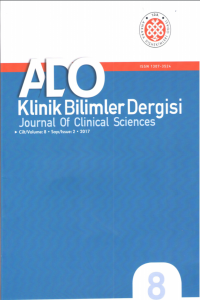ORTODONTİK ELASTOMERİK ZİNCİRLERDE OLUŞAN GERİLME DİRENCİ VE KUVVET KAYBININ DEĞERLENDİRİLMESİ
Elastomerik polimer, gerilme direnci, viskoelastik maddeler
EVALUATION OF TENSILE STRENGTH AND FORCE DECAY IN ORTHODONTIC ELASTOMERIC CHAINS
elastomeric polymer, tensile strength, viscoelastic substances,
___
- Referans1. Andreasen GF, Bishara S. Comparison of alastik chains with elastics involved with intra-arch molar to molar forces. Angle Orthod 1970;40:151-8.
- Referans2. Wong AK. Orthodontic elastic materials. Angle Orthod 1976;46:196-205.
- Referans3. Zhang C, Wen X, Vyavahare NR, Boland T. Synthesis and characterization of biodegradable elastomeric polyurethane scaffolds fabricated by the inkjet technique. Biomaterials 2008;29:3781-91.
- Referans4. Buchmann N, Senn C, Ball J, Brauchli L. Influence of initial strain on the force decay of currently available elastic chains over time. Angle Orthod 2012;82:529-35.
- Referans5. De Genova DC, McInnes-Ledoux P, Weinberg R, Shaye R. Force degradation of orthodontic elastomeric chains--a product comparison study. Am J Orthod 1985; 87:377-84.
- Referans6. Kovatch JS, Lautenschlager EP, Apfel DA, Keller JC. Loadextension- time behavior of orthodontic Alastiks. J Dent Res 1976;55:783-6.
- Referans7. Eliades T, Eliades G, Watts DC. Structural conformation of in vitro and in vivo aged orthodontic elastomeric modules. Eur J Orthod 1999;21:649-58.
- Referans8. Baty DL, Storie DJ,von Fraunhofer JA. Synthetic elastomeric chains: a literature review. Am J Orthod Dentofacial Orthop 1994;105:536-42.
- Referans9. Ash JL, Nikolai RJ. Relaxation of orthodontic elastomeric chains and modules in vitro and in vivo. J Dent Res 1978;57:685-90.
- Referans10. Killiany DM, Duplessis J. Relaxation of elastomeric chains. J Clin Orthod 1985;19:592-3.
- Referans11. Andhare P, Datana S, Agarwal SS, Chopra SS. Comparison of in vivo and in vitro force decay of elastomeric chains/modules: a systematic review and meta analysis. J World Fed Orthod 2021;10:155-62.
- Referans12. Weissheimer A, Lock A, de Menezes LM, Borgatto AF, Derech SD. In vitro evaluation of force degradation of elastomeric chains used in orthodontics. Dental Press J Orthod 2013;18:55-62.
- Referans13. Kassir CA, Daou M., Abboud M. Comparison of the force decay over time of four different brands of elastomeric chains (elongated to 25mm grey/transparent and closed/open): An invitro study. Int Orthod 2020;18:538-45.
- Referans14. Kardach H, Biedziak B, Olszewska A, Golusinska-Kardach E, Sokalski J. The mechanical strength of orthodontic elastomeric memory chains and plastic chains: An in vitro study. Adv Clin Exp Med 2017;26:373-78.
- Referans15. Masoud AI, Tsay TP, BeGole E, Bedran-Russo AK. Force decay evaluation of thermoplastic and thermoset elastomeric chains: A mechanical design comparison. Angle Orthod 2014;84:1026-33.
- Referans16. Yagura D, Baggio PE, Carreiro LS, Takahashi R. Deformation of elastomeric chains related to the amount and time of stretching. Dental Press J Orthod 2013;18:136-42.
- Referans17. Lu TC, Wang WN, Tarng TH, Chen JW. Force decay of elastomeric chain--a serial study. Part II. Am J Orthod Dentofacial Orthop 1993;104:373-7.
- Referans18. Santos AC, Tortamano A, Naccarato SR, Dominguez- Rodriguez GC, Vigorito JW. An in vitro comparison of the force decay generated by different commercially available elastomeric chains and NiTi closed coil springs. Braz Oral Res 2007;21:51-7.
- Referans19. Eliades T, Eliades G, Silikas N, Watts DC. Tensile properties of orthodontic elastomeric chains. Eur J Orthod 2004;26:157-62.
- Referans20. Halimi A, Azeroual MF, Doukkali A, El Mabrouk K, Zaoui F. Elastomeric chain force decay in artificial saliva: an in vitro study. Int Orthod 2013;11:60-70.
- Referans21. Ferriter JP, Meyers CE, Lorton L. The effect of hydrogen ion concentration on the force-degradation rate of orthodontic polyurethane chain elastics. Am J Orthod Dentofacial Orthop 1990;98:404-10.
- Referans22. Kumar K, Shetty S, Krithika MJ, Cyriac B. Effect of commonly used beverage, soft drink, and mouthwash on force delivered by elastomeric chain: a comparative in vitro study. J Int Oral Health 2014;6:7-10.
- Referans23. Behnaz M, Dalaie K, Hosseinpour S, Namvar F, Kazemi L. The effect of toothpastes with bleaching agents on the force decay of elastomeric orthodontic chains. Eur J Dent 2017;11:427-31.
- Referans24. Dadgar S, Sobouti F, Armin M, Ebrahiminasab P, Moosazadeh M, Rakhshan V. Effects of 6 different chemical treatments on force kinetics of memory elastic chains versus conventional chains: An in vitro study. Int Orthod 2020;18:349-58.
- Referans25. Kuster R, Ingervall B, Bürgin W. Laboratory and intra-oral tests of the degradation of elastic chains. Eur J Orthod 1986;8:202-8.
- Referans26. Birkeland JM. The effect of pH on the interaction of fluoride and salivary ions. Caries Res 1973;7:11-8.
- Referans27. Humphrey SP, Williamson RT. A review of saliva: normal composition, flow, and function. J Prosthet Dent 2001;85:162-9.
- Referans28. Kanchana P, Godfrey K. Calibration of force extension and force degradation characteristics of orthodontic latex elastics. Am J Orthod Dentofacial Orthop 2000;118:280-7.
- Referans29. Dagdeviren C, Gulec A, Eksi F, Saglam M, Kahraman M. Contamination of low frictional elastomeric ligatures by streptococcus mutans: A prospective RT-PCR and AFM study. Turk J Orthod 2021;34:163-9.
- Referans30. Moghaddam SF, Kamalı MD. Force decay and discoloration of thermoplastic and thermoset orthodontic elastomeric chains. Braz Dent Sci 2022;25:e2612
- ISSN: 1307-3540
- Yayın Aralığı: Yılda 3 Sayı
- Başlangıç: 2006
- Yayıncı: Ankara Diş Hekimleri Odası
Gökçen AKÇİÇEK, Şevket Murat ÖZBEK, Hatice Yağmur ZENGİN
Dental İmplant Çeşitleri Ve Biyomateryaller
Mustafa Kenan HÜRMÜZLÜ, Nur MOLLAOĞLU
Gömülü Kanin Varlığı ile Maksiller Diş Boyutları Arasındaki İlişkinin Değerlendirilmesi
Ezgi SUNAL AKTÜRK, Elif KOÇ, Fatma DERİN, Berza SEN YİLMAZ
ORTODONTİK ELASTOMERİK ZİNCİRLERDE OLUŞAN GERİLME DİRENCİ VE KUVVET KAYBININ DEĞERLENDİRİLMESİ
Genetik Faktörlerin Diş Çürüğü Üzerine Etkisinin Değerlendirilmesi
Diş Hekimliğinde Biyoaktif Camların Kullanımı
Ece UÇAR BAŞOL, Işıl ÇEKİÇ NAGAŞ
ALT ÜÇÜNCÜ MOLAR DİŞLERİN ALT İKİNCİ MOLAR VE ALT KANİN DİŞLERİNİN EKSEN EĞİMLERİNE OLAN ETKİSİ
Bozkurt Kubilay IŞIK, Ahmet Ertan SOĞANCI, Arif Yiğit GÜLER, Dilek MENZİLETOĞLU
TEMPOROMANDİBULER BOZUKLUKLARIN ETİYOLOJİSİNDE STRES
Esma Betül YILMAZ, Cansu ALPASLAN
MANDİBULANIN PATOLOJİK KIRIK NEDENLERİ VE KRİTİK BOYUT DEFEKTİ KAVRAMI
